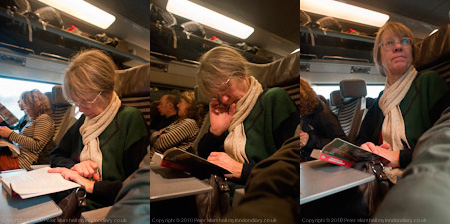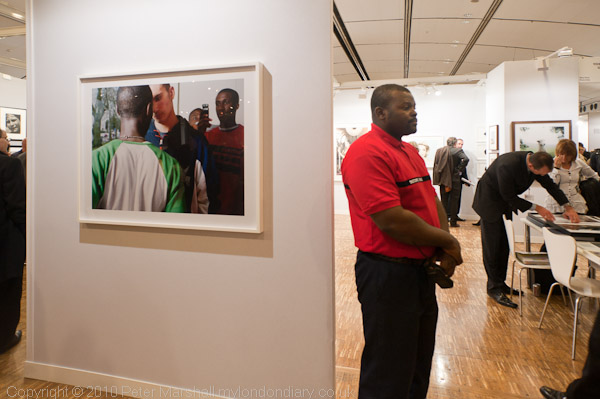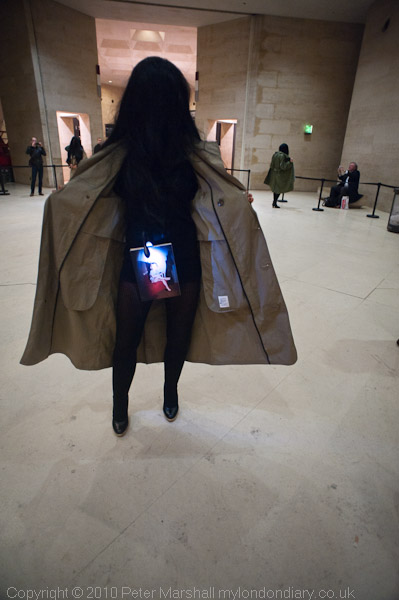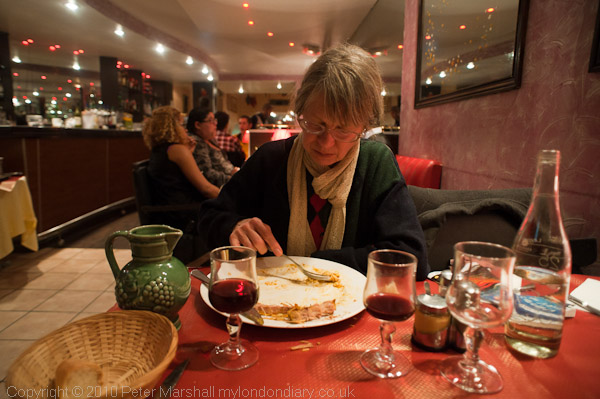Our Eurostar train got through London from St Pancras at an impressive lick and soon we were at Thurrock before diving down under the Thames to stop at Ebbsfleet. Where almost every passenger probably looked out of the window and said “Where the hell is this?” as we stopped in a deserted station. But soon it was on its way, sweeping across the Medway and on, and we were in the tunnel and arriving in France before I’d had time to finish my sandwiches and the small bottle of red wine I’d taken for the journey.

England – Tunnel – France
Getting to Paris took a little longer, but we were pulling into the Gare du Nord just around 138 minutes after leaving St Pancras, a couple of minutes early, and hurrying along to the RATP ticket office to get ourselves a Navigo Découverte card which would carry us around Paris on buses and Metro for what seemed a rather small sum for those accustomed to London fares. So my next significant photograph was a rather small – 25x30mm one of myself, which I slid across the counter and was then attached to a card in a thin plastic sleeve.

Navigo Découverte
Once you’ve paid 5 euros for the card, you can charge it with a week’s travel across the city of around 18 euros. Unlike London’s Oyster card there are no arcane regulations, although it is less flexible in that the weekly season can only run from Monday to Sunday, and you can only buy it up to Wednesday in any week. But all in all it’s a much better system.
We didn’t need the Navigo to get to our hotel – it was just a short walk – but I wanted to rush off for Paris Photo as soon as we had booked in. This took a little longer than expected as when we arrived we were taken a quarter of a mile to another hotel for our first night as maintenance work meant our room would not be ready until the following day. Fortunately the new hotel was equally close to the metro and soon we were able to rush out to take the train to Paris Photo (PP).

Salle Delorme, Paris Photo
PP takes place in a subterranean shopping and conference centre, Le Carrousel du Louvre, underneath the Louvre and the Jardin du Carrousel. Two short escalators take you down from street level on the rue du Rivoli or you can exit directly from the line 1 Metro station and walk a couple of hundred yards to the show. From the ticket hall you enter into a central area which includes a number of smaller stalls for publishers, a cloakroom, a bar area, offices and a small exhibition area as well as a stand featuring a BMW or two – BMW are the major sponsors of the show. They provide the money for the BMW-Paris Photo Prize, the short-listed entries for which are up some wide steps on a mezzanine floor above the rear of the central area.
Off three sides of the central area are three exhibition halls with the stand of the various galleries and larger publishers taking part. The stands vary in size, and even more in the number of photographs on show, with some having only a few mural size images and others being crammed with much smaller work – even done to some showing small contact prints.
The only way I can cope with such a huge show – 106 exhibitors from 25 countries – is to approach it in a systematic way, working around the 3 major exhibition halls. I started during the press launch and opening on Wednesday by working around the outer stands of the Salle Le Notre, then moving on to the outside of the Salle Soufflot and finishing with a part of the outside of the Salle Delorme, and coming back in later days to finish the circuit and do the inner blocks of each room. It was the only way I could be sure of seeing everything.
Of course some stands did not detain me long. Many had work that either did not interest me, or that I was already very familiar with. It is sometimes nice to see work you really like “in the flesh” like the Kertesz image Martinique (on the Stephen Daiter Gallery stand and later I found it elsewhere) I’ve written about at some length from its reproduction, though just occasionally the experience can be disappointing, but I’m really more interested in discovering new work that excites me.
Another of the good things about PP is that virtually everyone seems quite happy with people taking pictures of the pictures, unlike many museum and gallery shows – though the only place I went to during the six days I was in Paris where photography was explicitly banned was the Maison Européenne de la Photographie (MEP), though with almost everyone now carrying a camera-phone such bans are virtually impossible to enforce.
One thing that struck me on that first night – and a partial look at PP, was there number of pictures by Bernard Plossu, with a particularly nice set on the stand of Galerie Le Réverbère, Lyon. Plossu is a French photographer whose work has long interested me, and I have a couple of his books including perhaps his best work, ‘New Mexico’. There is a large amount of his work on the ‘documentsdartistes’ web site – click on the images on the thumbnails page to see more.
The work shown by dealers at PP relates to that on show elsewhere in Paris, so Plossu is the major artist in a splendid free show, part of the Mois de la Photo (MdP), ‘Nous avons fait un tres beau voyage‘ at the Hotel de Sauroy (58 rue Charlot, Paris, 3e) until 15 December 2010. It’s a show I very much enjoyed when I saw it later in the week.
There was a lot of Kertesz’s work throughout PP too, to link with his major show at the Jeu de Paume (1 place de la Concorde, Paris 8e) until 6 Feb 2010. Although I’m a great fan of Kertesz, I have seen his pictures so many times. I also have several books of his work and although I enjoyed seeing the many prints of his on display at PP didn’t feel any need to spend time going to see another show of his work as well.
I was particularly struck by a small set of 5 pictures by Lise Sarfati on the Brancolini Grimaldi stand, from her series ‘She‘; the two images of ‘Christine‘ one in a wedding dress and the other apparently in the middle of a desert in California stood out for me.
It’s always good too, to see work by photographers I’ve written about before – and especially if I’ve actually met them. There were some of Vanessa Winship‘s pictures on the ‘Vu Galerie‘ stand (and more of her work from Turkey on ‘The Empty Quarter‘. Vu also had some pictures by John Davies, particularly one from Widnes and another from Blaenau Ffestiniog that I admire. They were also showing the work of Denis Darzacq, although I found these images from his ‘Hyper‘ somewhat less striking than his earlier work in ‘La Chute‘.
But the most striking of all the new work that I saw on that first evening were a large set – around 16 – prints by Lee Friedlander from his ‘America By Car’ series of 192 prints showing at the Whitney Museum in New York until 28 Nov 2010 and at PP on the Janet Borden stand. You can watch the pages of the book of the work being turned on YouTube.
This is inventive and well-printed work that really fits well into the square format and came as something of a shock in the middle of a show rather dominated by very large (and often poorly printed colour images. Much of the black and white work around the show – with notable exceptions – isn’t well printed either, so it was a delight to come upon this set.
Just how many ways can you make use of the structure of a car – its door posts, mirrors, fascia , window – in a photograph. Certainly on the evidence here, rather more than sixteen. Of course the content framed by the car is also both vital and in Friedlander’s case superbly matched, the two integrated into a vibrant whole by the work of the printer.

QQQOC counter-event outside Paris Photo
Having seen this, it seemed a good time to leave PP for the day on a high note, and in any case I needed some dinner, and it was time to meet Linda again. On the way out from PP we were greeted by several women in long coats who were rushing up to people and ‘flashing’ open their coats to reveal an illuminated photograph. This was a ‘CONTRE évènement’ against Paris Photo, inspired by its Central European theme and the clandestine circulation of ideas necessitated by state censorship. You can read more about that – in French – and watch videos of the QQQOC artists confronting those leaving and entering PP.

We took a short stroll through the centre of the city to enjoy a leisurely and pleasant cafe meal. Afterwards we strolled again through the Isle St Louis and then looked in vain for a bus back towards our hotel. Fortunately we were still in plenty of time for the Metro.
A few more pictures are now on My London Diary.